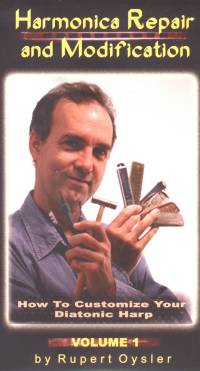 |
Rupert Oysler : Harmonica Repair and
Modification
A few months back, Rupert Oysler released a series
of two 90 mn videos entitled :
Harmonica Repair and Modification (vol 1 & vol 2) To my
knowledge, this is the first effort at releasing a video series
which deals not with playing the harmonica but with working
on the instrument to make it play better. Since then, I believe
another video on the subject was released, but I haven't been
able to get hold of it in order to compare. These videos feature
only diatonic harmonicas, but most of what is shown is applicable
to the chromatic harmonica as well.
Rupert's videos are as simple as they are informative.
There's no fancy stuff, it's just mainly him talking and showing
you how to do what he's talking about. By the end of the two
videos, you'll know all about his looks, his dimples, his damaged
right thumbnail, etc. Rupert has a clear and audible voice,
and a very humble way of putting his ideas and experiments forth,
which makes all this custom wizardry seem very accessible.
Rupert also has a nice dry humor and peppers his
video workshop with little anecdotes and jokes that really make
it fresh and keep you interested even after 60 minutes of seeing
a guy tweaking his harp. Now let's move on to the content :
First of all, both videos start with a feature
on tools, where they come from, what they do. A lot of Rupert's
tools are homemade, and I guess it's not that hard to do your
own although it would be nice to be able to purchase some of
the quite clever ones. Maybe Rupert should commercialise a kit
of homemade tools along with the videos !
The first video then describes what would be considered
as the "basics" of harp adjustment, mainly focusing
on gapping and retuning. Both these sections are very detailed
and include a lot of little tips that you don't find in any
book but are really helpful to make things easier when you try
to adjust or retune your harmonica. Rupert addresses the issue
of which tuners to use as well and demonstrates both retuning
and gapping. He also comments on the most efficient way of doing
these adjustments in terms of disassembly and reassembly of
the harp itself. While I'm writing this I think I give the impression
that it's no big deal, but really, what makes the value of the
video is all the little comments and techniques that Rupert
uses and demonstrates. Hard to express that in a few words.
Also, there's a great value in "seeing it done". It
gives the viewer the feeling that it can be done, and that,
to be frank, it's not that hard. Of course, Rupert warns the
viewer repeatedly that there is a learning curve and that it
all takes much time, but to be honest a lot of what's shown
is feasible with patience and precision.
The second video is much in the same vein but
demonstrates a lot more advanced techniques. It starts with
reed replacement, which eats up about a third of the video since
there are a lot of specific tools and tehcniques involved, and
Rupert demonstrates both a "lucky" reed replacement
and one that does not go so well, so you can see for yourself
how to cope with both. He then continues with advanced techniques
designed to ease overbending capability. I was particularly
impressed and pleased to understand at last what chamfering
and embossing were all about. This video really gives a good
idea of exactly how much can be involved in customising a harmonica,
and it puts in perspective the pricetag that we often see on
customised harp. You can do it yourself, that's what Rupert
does, but you're going to spend a lot of time working on it.
Then again, as Rupert repeatedly points out, you're the best
person to identify what you like and dislike in the way your
harp plays once it's customised...
All in all, I can boldly say that this is an outstanding
product. If you're looking for basics just to get your harps
going better, then vol. 1 is probably enough for you, but if
you want to understand and experiment with more advandced techniques,
you should get vol. 2 as well (or vol. 2 stand-alone if you're
already confident on gapping, retuning, etc.) What's great about
these videos is that there are a lot of close-ups that enable
you to really see and understand what's going on. The video
medium is, in my opinion, the most appropriate for this kind
of information. Plus you'll be able to say you own a Harmonica
DIY video !
One word of warning for non-american customers
: the video is in NTSC format so unless your VCR can read NTSC,
you're out of luck until Rupert releases the Collector's Edition
"Harmonica Repair and Modification" on DVD !!!
For more details: http://www.harprepair.com/
|